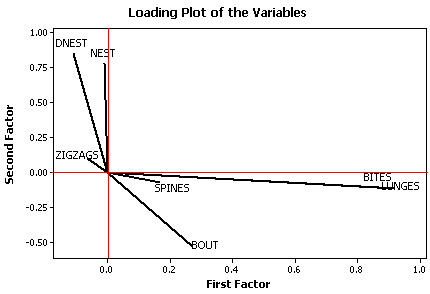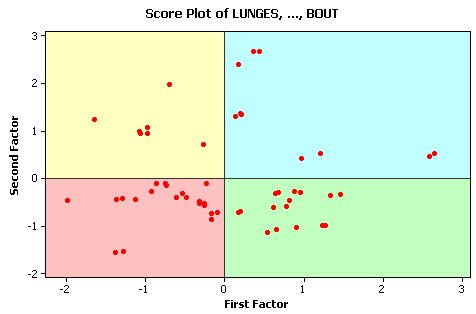
This is the same analysis as the previous PCA, (four components extarcted) but the extracted factors are subjected to a Varimax rotation. In addition the rotated loadings have been sorted and set to 0 (if < 0.2) to ease the interpretation.
Principal Component Factor Analysis of the Correlation Matrix Rotated Factor Loadings and Communalities Varimax Rotation Variable Factor1 Factor2 Factor3 Factor4 Communality LUNGES 0.921 -0.118 0.096 -0.082 0.878 BITES 0.868 -0.107 -0.331 0.000 0.875 ZIGZAGS -0.066 0.100 -0.064 0.965 0.951 NEST -0.011 0.784 0.092 0.395 0.780 SPINES 0.167 -0.069 -0.901 0.049 0.848 DNEST -0.110 0.854 0.072 -0.074 0.752 BOUT 0.270 -0.535 0.406 -0.038 0.525 Variance 1.7199 1.6698 1.1137 1.1043 5.6076 % Var 0.246 0.239 0.159 0.158 0.801 Sorted Rotated Factor Loadings and Communalities Variable Factor1 Factor2 Factor3 Factor4 Communality LUNGES 0.921* 0.000 0.000 0.000 0.878 BITES 0.868* 0.000 -0.331* 0.000 0.875 DNEST 0.000 0.854* 0.000 0.000 0.752 NEST 0.000 0.784* 0.000 0.395* 0.780 BOUT 0.270* -0.535* 0.406* 0.000 0.525 SPINES 0.000 0.000 -0.901* 0.000 0.848 ZIGZAGS 0.000 0.000 0.000 0.965* 0.951 Variance 1.7199 1.6698 1.1137 1.1043 5.6076 % Var 0.246 0.239 0.159 0.158 0.801
The inital (not shown) component loading matrix is identical to the 4-component PCA. The important rotated loadings have been marked with an asterisk (by me) to highlight the patterns.
We now have a much simpler, and more clearly delineated pattern of loadings.
1. Lunges, Bites & Bouts: may be interpreted as 'Aggression' 2. Nest, Dnest & Bouts (negative): may be interpreted as 'Nest Activity' 3. Bites, Spines & Bouts (negative): a different type of 'Aggression 4. Zigzags & Nest: female-centered display
The loadings on the first two factors are also clear from the loading plot. The first factor (horizontal) is obviously mainly BITES and LUNGES. BOUT also has a moderate loading on this, and the second, factor. Factor two is mainly the nest building variables: DNEST and NEST.

This is a much more successful analysis, in which the dimensionality has been reduced from seven to four and the extracted factors can be interpreted to produce a biologically reasonable interpretation.
The following plot shows the scores for the cases on the first two of the new components: 'Aggression' and 'Nest Activity'. The plot has been split into 4 sections using shading. The boundaries are at 0 on both axes.

1. Pale yellow: below average Factor 1 and above average F2. Thus, these individuals did not show much aggression but spent a lot of time on nest building activities. 2. Pale blue: above average on both axes. Thus, they combine above average aggression with a lot of nest building activities. Note the lack of points along the diagonal, why?(think about what the fish would have to do to get on the diagonal) 3. Pale pink: below average on both axes. These individuals didn't do much! 4. Pale green: above average on factor 1 and below average of factor 2. These individuals did not spend much time on nest building but were above average with respect to aggression.